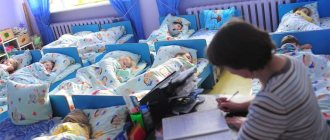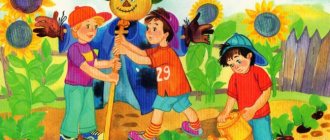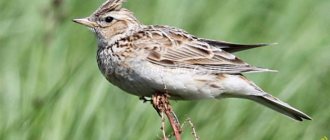The daily routine in kindergarten for all age groups of the kindergarten is based on SanPiN standards, and is designed for a 12-hour stay of a child in a preschool institution. The daily routine in a preschool institution is a strict, down to the minute, sequence of walks, meals, activities, games and daytime rest.
Peppa Pig
Peppa Pig
Thanks to such a regimented daily routine in kindergarten, the preschooler develops discipline, a love of order, and the ability to manage his own time, which will facilitate adaptation to school in the future.
In preschool institutions in our country, it is customary to divide children into groups by age. So, the early age group is from 2 to 3 years old; junior group - 3-4 years; middle group - 4-5 years; senior group - 5-6 years; preparatory group 6-7 years old.
However, regardless of the age of the preschooler, the daily routine in kindergarten begins at 7 am, when teachers receive children, and the “working day” in kindergarten begins at 8 am.
Approximate daily routine for a preschooler
7.00-8.30 - Reception of children 8.10 - Exercise 8.30 - Breakfast 9.00-10.00 - Classes 10.30-11.30 - Walk 12.00 - Lunch 12.30-15.00 - Day nap 15.30 - Afternoon snack 16.00-17.00 - Classes 17.00 - Pro party 18:00 - Dinner 19.00 - Care children home
As can be seen from the schedule, according to the recommendations of SanPiN, a kindergarten pupil is provided with four meals a day, with an interval of 4 hours between meals, there are also two walks, one of which is in the afternoon (the time of which may be reduced due to weather conditions), in addition, it is mandatory nap, and of course there is time for activities and games.
It is worth noting that there are slight differences in the daily routine of each group in kindergarten, which take into account the age characteristics of the children.
For example, if the duration of classes in the junior group of a kindergarten is only 10 minutes, then preschoolers of the senior and preparatory groups study for 20-30 minutes, which is close to school classes. The same applies to preparatory moments and getting ready - older children need less time to get dressed for a walk, or wash their hands before lunch.
Next, we will look at several important points from the daily routine in kindergarten in more detail.
“SanPin requirements for organizing a walk.” For teachers
Pavlenko Aigul Minniaksanovna
“SanPin requirements for organizing a walk.” For teachers
Requirements for equipment and sanitary maintenance of preschool educational institutions for walks
1. Equipment and sanitary maintenance of areas must comply with Section III. Requirements for equipment and maintenance of territories of preschool educational organizations SanPiN 2.4.1.3049-13 .
2. Playing and economic zones are allocated on the territory of the preschool educational institution. The play area includes group playgrounds - individual for each group and a paved area.
3. Cleaning of areas is carried out daily: in the morning 1–2 hours before the children arrive or in the evening after the children leave, and also as the area gets dirty.
4. During the warm period of the year, washing the verandas is carried out 2 times a day before a daytime walk from 8.30 to 9.00 and during quiet hours from 13.30 to 14.30.
5. Play equipment in preschool groups is washed by the teacher in the evening at the end of the working day from 18.00 to 18.25. 6. Watering of sandboxes is carried out 2 times a day before children are received from 6.30 to 6.45 and during quiet hours from 13.30 to 13.45.
7. In dry and hot weather, watering of plots is carried out at least 2 times a day before children are received from 6.00 to 7.00 and during quiet hours from 13.30 to 14.30.
8. In the hot season, walking verandas , and collapsible tents are installed to protect children from the sun.
9. To store toys used on the territory of the preschool educational institution, there is a warehouse on the walking area of each group.
10. A complete change of sand on group sites is carried out annually, in the spring (May)
.
11. In the absence of children, sandboxes are covered with protective devices to prevent sand contamination. If pathogens of parasitic diseases are detected, an extraordinary change of sand is carried out.
Safety requirements when organizing walks in preschool areas.
1. Every day, 2 times a day, before the children arrive at 6.30 and at 14.30, teachers inspect the territory of the sites for compliance with safety requirements . Teachers leave a note about the inspection of the territory in the “Log of Inspection of the Territory of the MBDOU”
2. Before going for a walk, preschool workers who are involved in dressing children make sure that pupils do not remain dressed indoors for a long time in order to avoid overheating, as well as that children’s clothes and shoes are in good working order and suit the weather conditions.
3. When conducting a walk, the teacher makes sure that the children do not leave the territory of the preschool educational institution.
4. During the walk , the teacher teaches children safe behavior skills and rules for safe handling of various objects.
5. When choosing games, the teacher takes into account the psychophysiological characteristics of children of a given age, the area of the walking area , and weather conditions.
6. Teachers are prohibited from leaving children unattended or using sharp, piercing, cutting objects or broken toys in children's games.
7. In the event of a child’s unauthorized departure, the teacher immediately reports the incident to the head of the preschool educational institution or his substitute.
8. The teacher immediately notifies the medical worker, the head of the preschool educational institution or his deputy about each accident with the child.
Requirements for the content of walks
1. A walk with students consists of the following structural elements: observation; physical activity: outdoor activities, sports games, sports exercises, etc.; individual work; work assignments; independent activity of children. 2. The sequence of structural components of the walk varies depending on the type of previous organized educational activity.
3. If the children were in an activity that required increased cognitive activity and mental stress, then first they conduct outdoor games, then observations. If before the walk there was a physical education or music lesson, then the walk begins with observation or quiet play.
4. The content of walks is determined taking into account the Program , in accordance with the work plan for each specific age group.
5. Depending on the content of the upcoming walk , the teacher prepares in advance the necessary take-out material and manuals for various types of children's activities that meet sanitary and hygienic requirements .
6. Depending on weather conditions, the organized motor activity of children during a walk varies in intensity so that they do not become overcooled or overheated.
7. Children are not allowed to spend a long time walking without moving . Particular attention is paid to pupils with reduced mobility and low initiative, who should be involved in outdoor games.
8. During the cold season at low air temperatures, high mobility games are not organized .
9. Throughout the walk, the teacher constantly monitors the children’s activities.
Requirements for the duration of the walk .
1. Walks are organized 2 times a day : in the first half of the day and in the second half of the day - after a nap or before the children go home. During the warm period - 3 times.
2. The time when children go for a walk is determined by the daily routine of each age group, approved by order of the head of the preschool educational institution.
3. The total duration of daily walks is 3–4 hours .
4. The duration of the walk is determined by the preschool educational institution depending on climatic conditions and weather conditions.
5. When the air temperature is below minus 15 °C and the wind speed is more than 7 m/s, the duration of the walk is reduced .
6. To achieve a healing effect in the summer, the daily routine provides for children to spend maximum time in the fresh air with breaks for meals and sleep.
7. In the event of cancellation of walks in preschool districts due to weather conditions, are organized that compensate for the lack of physical activity in the premises of the preschool institution.
Kindergarten classes
As mentioned above, the duration of classes depends on the age of the child. A lesson in the junior group lasts 10 minutes, 15 minutes in the middle group, 20-30 minutes in the senior and preparatory groups.
In these classes, the preschooler learns a lot of new things, begins to form his horizons, and becomes familiar with the basics of writing and mathematics. If the kindergarten is specialized, with a certain focus, then additional classes may be included in the schedule. Also, the schedule in the middle and senior groups may include additional thematic classes and developmental clubs.
In kindergarten, not only the time of classes is regulated, but also their distribution throughout the day. The schedule is drawn up so that children not only do not become overtired, but also make the most of their activity.
Thus, classes that require increased concentration are carried out in the first half of the day, between 9 and 12 hours, all others - in the afternoon, between 16 and 18 hours. Activities that require perseverance and attention alternate with outdoor games and gymnastic warm-ups.
In addition, the most complex subjects, such as the basics of mathematics and writing, and speech development, are scheduled in the first days of the week, when preschoolers are most alert; for the rest (music classes, drawing, etc.) the second half of the week is usually reserved.
SANPIN REQUIREMENTS FOR ORGANIZING A WALKconsultation
SANPIN REQUIREMENTS FOR ORGANIZING A WALK
It is perhaps difficult to overestimate the importance of a walk in kindergarten. During a walk, children move actively, breathe fresh air, learn about the world around them, and get accustomed to work. All this is beneficial for the health, physical and mental development of children.
Sanitary standards (SanPiN dated May 15, 2013 N 26 ABOUT APPROVAL SANPIN 2.4.1.3049-13 “Sanitary and epidemiological requirements for the design, maintenance and organization of work in preschool organizations) determine that the daily duration of children’s walks is at least 3-4 hours.
The walk is organized 2 times a day: in the first half - before lunch and in the second half - after a nap or before the children go home. When the air temperature is below -15°C and the wind speed is more than 7 m/s, the duration of the walk is reduced. The walk is not carried out at an air temperature below -15 ° C and a wind speed of more than 15 m/s for children under 4 years old, and for children 5–7 years old - at an air temperature below minus 20 ° C and a wind speed of more than 15 m/s;
During the walk, pupils are provided with physical activity and reasonable clothing depending on weather conditions, including in winter.
The reason for a child’s frequent illness cannot be directly dependent on the activities carried out in kindergarten. On the contrary, the kindergarten implements physical education and health activities aimed at strengthening the health of each child.
Requirements for equipping the kindergarten territory:
1. It is necessary to inspect the areas every day before the walk: all equipment on the site must be in good condition (without sharp protrusions of corners, nails, roughness and protruding bolts), small play forms, physical education aids, etc. must meet the age of the children and the requirements of SanPiN; 2. Outdoor and didactic material for children’s games must correspond to the autumn-winter period. Toys must be hygienic, not broken, for different types of play activities, allowing the physical load to be balanced in accordance with the season of the year and the age of the children; 3. Kindergarten fences should not have holes or openings to prevent the entry of stray dogs and unauthorized leaving of children; 4. Pits on the territory must be filled in, wells must be covered with heavy lids; 5. If dangerous and suspicious objects are found at the site, immediately inform the administration (security guard), and take the children to another site or premises; 6. The kindergarten gates must be locked; 7. If a child leaves without authorization, immediately send an employee to look for him and report the incident to the nearest police station; 8. The requirements for the manufacture of snow structures (slides, slides, snow tracks, etc.) must be met.
When organizing walks in the autumn - winter period, you should: 1. Dress children in accordance with temperature conditions, avoid: - frostbite, hypothermia or overheating of the child’s body; — getting children's clothes and shoes wet; 2. Protect children from exposure to the following dangerous factors characteristic of the autumn-winter period: - injuries during games on areas that are not cleared of snow and ice; — injuries from icicles falling from roofs, hanging blocks of snow during the thaw period; - falling from a slide, in cases where the teacher does not have insurance (provide control and direct insurance by the teacher while sliding down a slide, climbing, jumping from a hill, sports equipment, throwing); - injury: from metal or wooden stands of objects sticking out of the ground, low stumps on areas for outdoor games, injections from broken glass, dry branches, twigs on trees, bushes, splinters from sticks, boards, wooden toys, etc.; — injuries to the legs of pupils: in the presence of holes and potholes in the area, when jumping from stationary equipment without the teacher’s insurance; — injuries when sliding on an ice path; — when organizing the work of preschool children; - injuries, bruises during games with sports elements; - injuries, bruises during games on a wet and slippery surface; - injuries, bruises when sliding down ice slides, on sleds, while moving in icy conditions on slippery paths, external steps, areas not cleared of snow, ice and not sprinkled with sand; — injuries from touching metal structures with exposed parts of the body (face, hands, tongue, lips) on a frosty day; Avoid: - infection with gastrointestinal diseases, acute respiratory infections, if the child puts dirty and cold snow or icicles in his mouth. - clear the roofs of all buildings from snow, sprinkle icicles with sand.
Each teacher and all substitute teachers must teach children to recognize dangerous situations in illustrations and explain to children. Agree with the head nurse and manager about the possibility of going for a walk depending on the weather conditions and air temperature. The teacher must inspect the clothes and shoes of the pupils for compliance with weather conditions. Children should always be provided with spare things in case of bad weather, which parents bring in advance for this purpose;
Safety requirements while walking
1. It is not allowed to organize walks, work in one play area at the same time for 2 groups of pupils, the presence of parents on an evening walk 2. The teacher provides supervision, control over the calm exit of pupils from the premises and descent from the porch, do not run, do not push, when descending and ascending to the 2nd floor, hold onto the railings, do not carry large toys and objects in front of you that block the view of the path, etc. Additional safety requirements during a walk in winter: 1. Ensure control and direct insurance by the teacher of pupils while sliding on ice paths, riding sledding; 2. Make sure that when sledding, the next child waits patiently until the child sliding in front of him reaches the end of the ramp or slide; 3. When sledding down a hill, do not allow children to sit with their backs to the slope; 4. Make sure that children do not put dirty snow or icicles in their mouths; 5. If frost and wind become stronger, take children to the kindergarten premises;
Safety requirements in situations while walking:
1. All employees temporarily replacing the teacher in the group take on the functions of rescuing children. 2. If unforeseen situations arise, it is necessary to: - ensure the safety of children; — make sure there is no dangerous situation; — inform the administration about the incident, provide first aid in case of an accident; — notify the rescue service by phone if the situation requires it.
Safety requirements at the end of the walk
1. Organize a calm entry of pupils into the kindergarten premises (1st subgroup passes and undresses under the supervision of an assistant teacher, 2nd - under the supervision of a teacher). 2. Clean students’ outer clothing and shoes from snow, dirt, and sand. 3. Check how the students put their clothes in the lockers. If necessary, change the pupils into dry clothes and underwear. 4. Organize hygiene procedures: visiting the toilet, washing hands with soap. 5. Ensure drying of wet clothes and shoes after rain or in winter.
Types of walks in kindergarten
1. At the venue:
• on the territory of the kindergarten;
• outside the territory of the kindergarten (possible in older groups, over short distances).
2. By content:
• traditional, which includes children’s work activities (cleaning up leaves, snow, etc.), active and quiet games, etc.;
• thematic: consisting of observations and conversations on a specific topic (animals, clouds, trees, city transport, etc.), can be a street theater performance, a quest with overcoming simple obstacles - requires a pre-prepared script;
• targeted: organized exit outside the territory of the kindergarten, over a short distance (up to 2 km);
• excursion (usually a museum tour): once a month, starting from the middle group;
• hike: can be carried out 1-2 times a year in older groups.
Meals
The main meals in kindergarten are breakfast, lunch, afternoon snack and dinner, if the child is in kindergarten until 19:00.
In all preschool institutions, regardless of their focus, meals are scheduled at approximately the same time: at 8.00-8. 30 breakfast, 12.00-13.00 lunch, 15.00-15.30 afternoon tea, 18.00 dinner.
In the daily routine according to SanPiN, each meal is preceded by preparation: children wash their hands and sit down at tables. The time for this preparation is also regulated and reduced depending on the age group.
Walks and quiet time
These important components of the daycare routine are also age-appropriate.
Children from the early age group go for a walk earlier than others, at 9.00-9.30. The quiet hour has also been increased - babies sleep on average from 12.30 to 15.00.
Children from the senior group and the preparatory group go to a quiet hour at 13.00; their sleep lasts an average of 1.5 hours. They also have a shorter time to prepare for a walk - children at this age can already independently and quickly change clothes for playing in the fresh air.
However, regardless of age, quiet time in kindergartens ends at 15.00. After afternoon tea, the younger groups have a general education lesson; students from the middle and older groups are engaged in games or independent activities.
During the second walk, the children are gradually picked up by their parents. In winter, due to the fact that it gets dark quite early, the time for the second walk is reduced, and children are taken directly from kindergarten. Also, the walk may be shortened due to weather conditions: for example, frost or strong wind.
Walks for different age groups
Vera Kostikova
Walks for different age groups
A walk takes up considerable time in the daily routine of preschool children and has enormous pedagogical significance. According to SanPiN 2.4.1.3049-13 “Sanitary and epidemiological requirements for the design, content and organization of the operating mode of preschool educational organizations,” approved. By Decree of the Chief State Sanitary Doctor of the Russian Federation dated May 15, 2013 No. 26, the recommended duration of daily walks is 3–4 hours . The duration of the walk is determined by the preschool educational organization depending on climatic conditions. The time allotted for walking must be strictly observed. is organized twice a day : in the first half of the day and in the second half of the day - after a nap or before the children go home.
• The structural components of the walk are : various observations ;
• work assignments;
•motor activity: outdoor activities, sports games and play exercises;
• independent activities of children;
• individual work in different areas of development of students.
These components act not as separate pedagogical events, but as logically sound parts of the main thing that is planned by the teacher in a specific age group during a walk , and make it more effective and interesting.
The sequence of structural components may vary depending on the type of previous educational activity. For example, if children were in an activity that required increased cognitive activity and mental stress, then first the walks there are outdoor games, jogging, and then observations. If before the walk there was a physical education or music lesson, then the walk begins with observation or quiet play.
Each of the required components of the walk lasts from 7 to 15 minutes and is carried out against the backdrop of children’s independent activity.
The physical activity of children during a walk should include :
- outdoor games and physical exercises on a morning walk : in the junior group - 6-10 minutes , in the middle group - 10-15 minutes , in the senior and preparatory groups - 20-25 minutes . On an evening walk : in the junior and middle groups - 10-15 minutes , in the senior and preparatory groups - 12-15 minutes . Outdoor games can be supplemented or replaced by sports exercises or, in older preschool age, sports games , games with elements of competition.
Requirements for children's clothing:
- at any time of the year, clothing and shoes must be appropriate for the current weather and should not overheat or overcool children;
— when temperatures fluctuate from +3 to -3°C and there is light wind, children’s clothing should consist of three layers, including underwear. Outerwear consists of an insulated jacket, trousers or gaiters; insulated boots on feet;
— at temperatures from -4 to -10°C, children wear a winter jacket or down jacket with three layers of clothing. — at lower temperatures, it is recommended to increase the number of layers of clothing to four or five, depending on the heat-protective properties of outerwear. — in the summer, to avoid overheating, children wear light hats.
To avoid overheating of children, it is necessary to adhere to the order of dressing: first, children put on tights, gaiters, then sweaters, overalls, shoes, and only lastly hats, outerwear and a scarf.
also return from . The junior teacher takes the first subgroup of children . Children of the second subgroup continue to walk for another 10-15 minutes with the teacher.
The duration of a walk outside in winter is reduced when the air temperature is lower and the wind speed is higher than the indicators established in the schedule for the age of the children .
1 junior group up to -15 C quiet - at least 1 hour
from -12 C wind up to 5 m/s – at least 30 minutes
2 junior groups up to -20 C quiet - at least 1 hour
from -18 C wind up to 5 m/s – at least 30 minutes
Medium groups up to -25 C quiet – at least 1 hour
from -20 C wind up to 7 m/s to - 24 C wind up to 2 m/s (inclusive)
– at least 30 minutes
Senior, preparatory groups up to -30 C quiet - at least 1 hour
from -25 C wind up to 10 m/s to -29 C wind up to 3 m/s (inclusive)
– at least 30 minutes
Planning for walks outside the site begins with the 2nd junior group .
When preparing for a walk , the teacher must first inspect the place of the walk , the route, and agree with the head. group's route should include as few crossings of the roadway as possible and, if possible, the use of only controlled crossings.
The head, or deputy head for educational and methodological work, appointed by order, conducts targeted briefing with an entry in the Journal of targeted briefing on organizing walks and excursions outside the Kindergarten site with all employees accompanying the children, agrees on the total number of children going for a walk .
In the case of a long walk, it is important to provide the required number of adults at the rate of one adult for 15 children. The teacher must first inspect the route and coordinate it with the head of the Kindergarten.
If for some reason the children from the group remain in the Kindergarten, they, on the instructions of the head of the Kindergarten, must be under the supervision of a certain employee who may be held responsible for the life and health of the children.
Children during walks and excursions outside the Kindergarten site must be accompanied by at least two adults. One of the accompanying persons is appointed senior.
Children line up in a column of two and take each other's hands. While moving in a column, children should not have any objects or toys in their hands.
One of those accompanying the column is in front of the group , the second is behind.
Each accompanying person must have a red flag. The group should be marked with red flags carried by the first and last pairs of children.
Forms of working with children on walks in winter .
When walking with children in winter, you can use the following forms of work:
• observing living and inanimate nature, feeding birds;
• conversations with children on any topic;
• stories of the teacher and students from personal experience;
• creating ice cubes and making patterns from them, decorating the site;
• modeling from snow;
• drawing in the snow;
• labor on site;
• conducting outdoor games in each age group ;
• reading fiction and acting out fairy tales;
• role-playing games using snow buildings;
• educational games for the development of memory, attention, thinking;
• a variety of motor activities: physical education classes (according to the schedule, physical education leisure, skiing, sledding, ice sledding, snowmobiling, various relay races and games using sleds and skis, games with snowballs, sliding along ice paths.
So, during a walk , you can invite children to watch the snow fall and look at the snowflakes on their clothes. The object of observation will be trees and birds. In order to have the opportunity to watch birds every day, the teacher and the children hang pre-made feeders on the site and bring out bread crumbs for them.
If it’s frosty outside, the teacher draws the pupils’ attention to how the snow crunches under their feet and explains why this happens. It will be interesting to observe the patterns on the glass. Together with the teacher, children can fantasize and find familiar shapes: a Christmas tree, snowy mountains, a white bunny, etc. During the walk , the children analyze the weather, and then in a group they enter the results of their observations into the nature calendar.
Conducting experiments with water will be educational. For example, by filling a mold with colored water, children will receive multi-colored ice cubes with which they can decorate the area.
If the snow is sticky, then you can use it as a building material and build a slide, a fortress, or just play snowballs. Taking some snow with them to the group , students will be able to watch it transform into water.
When introducing children to work, the teacher can invite them to cover trees and shrubs with snow, repair snow buildings (if necessary, take part in the construction of a snow fortress. When organizing games during a walk , it is important to ensure that all children are involved in this activity.
.
Planning the content of children's activities during a walk .
Planning the content of children's activities during a walk depends on the time of year, weather, previous types of direct educational activities, interests, age of the pupils and is built taking into account the main components of the walk .
The choice of game depends on the time of year, weather, air temperature. On cold days, it is advisable to start your walk with games of greater mobility associated with running, throwing, and jumping. In damp, rainy weather (especially in spring and autumn)
Sedentary games that do not require a lot of space should be organized.
On warm spring, summer days and early autumn, games with jumping, running, throwing, and balance exercises are organized. In hot weather, playing with water becomes popular. During walks , plotless folk games with objects and games with elements of sports games are widely used.
It is also necessary to pay attention to the work activities of children, the organization of which depends on the weather and time of year. For example, in the fall, students can collect flower seeds and harvests from the garden; in winter, they can rake snow and make various structures . The results of this activity can be presented as part of a review competition for the best snow building on the territory of a preschool educational institution. At the same time, it is important for the teacher to take into account that work tasks should be within the capabilities of children.
A large part of the walks is devoted to observations (pre-planned)
for natural phenomena and social life (including the labor of adults who work on the territory of the preschool educational institution or beyond).
Observations can be carried out with a group , a subgroup of students , as well as individually.
In addition, during walks , work is carried out to develop children’s speech. Together with the teacher, students learn short poems, proverbs, sayings, nursery rhymes, song lyrics, and also reinforce the pronunciation of “difficult” sounds. The main place during the walk is given to independent games of pupils.
During the walk it is important that all children are occupied. The teacher needs to ensure that the students do not freeze or overheat. About half an hour before the end of the walk , the teacher organizes quiet games. Then the children collect toys and equipment.
Games, joint and independent activities
Games and shared activities are very important for children. They teach children to communicate, develop creative thinking and imagination. During joint classes, a group of children completes tasks proposed by the teacher, thus preschoolers learn to work in a team and develop communication skills.
A total of three hours are allotted for independent games and activities, which allows the child to devote time to his own interests. Children play during the remaining time in such a tight schedule: before morning exercises, before and after classes, during walks.
- share with your friends!










